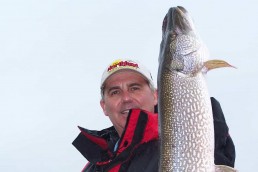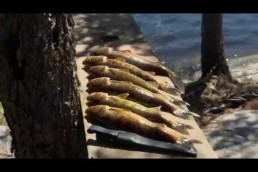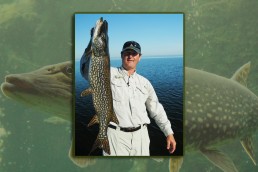Massive Canadian Northern Pike: Mean and Mobile
SHARE THIS POST
Catching reel monsters
All across Canada, a vast network of flowing water connects lakes, rivers and marshes ideal for spawning, rearing and growing northern pike to monstrous proportions. Given the overall cool climate, even relatively small and/or shallow waters are likely candidates for growing massive Canadian pike past the 40-inch, 20-plus-pound mark. It’s hard to imagine a more widespread trophy fishery anywhere on earth.
Rather than easing into spring activity following a long, cold winter, pike begin their season with a vengeance. Even as the ice is breaking, pike are already spawning amidst shallow marshes in the backs of bays. These same bays remain focal points for massive Canadian northern pike until early summer.
Anglers often assume that pike feed in the back ends of knee-deep bays. More likely, larger pike feed on suspended ciscoes outside the mouths of such bays, and begin sliding up into the bays in mid-to late morning to warm their bodies and enhance digestion. By mid-morning, you might see them entering the mouths of bays, swimming toward or lying inactive in shallow water near the back ends. At this time of day, they commonly ignore lures retrieved past their noses. Reach down and poke them with your rod tip, and they’ll kick their tails and scoot away. Which is why, as a general rule, it’s often best to fish for walleyes or lake trout in early morning, until the sun begins working its magic on pike by late morning.
Sunlight triggers strikes from massive Canadian pike
After an hour or two of exposure to sun-baked, warming water, pike attitude often changes from sluggish to ferocious, with fish willing to chase down and smash lures thrown anywhere near them. Yet not always. Even in the wilds of Canada, it pays to bring along a variety of lures, and experiment with retrieves ranging from subtle to aggressive. The challenge is to determine what works best on any particular day, or throughout the day as warming water progressively ramps up the activity of massive Canadian pike to the max.
Under most conditions, the slow, lazy wobbles of 3 1/2- to 4-inch Dardevles and Len Thompson spoons fascinate pike, causing them to follow like crazy. Follows are nice, but hookups are even better. Several times per retrieve, give your rod tip an upward pop, then pause, causing the spoon to shoot forward, then flutter. This triggers a following fish to kick its fins in pursuit, run up on the lure, and then grab it in a reflex strike.
Northern pike tricks and tactics
In general, lures that slide and glide, moving horizontally, are best. Large soft plastics like 9- to 10-inch Slug-Gos or Fin S Fish are fantastic. Twitch, glide, then pause to slowly sink them. How could a massive Canadian pike resist? Similar for working neutrally buoyant minnowbaits like #14 X Raps. The pause-and-suspend drives ‘em crazy.
Slowly crawl a wobbling crankbait just beneath the surface, allowing it to form a wake. As the giant wake of a massive Canadian pike zeros in on it, don’t anticipate and set the hook too early. If you set as the wakes collide, you risk jerking the lure away from opening jaws. Wait for the tug, then slam the hook home.
Modest-size, #4 or #5 straight-shaft Mepps or Blue Fox spinners excel for pike. So do 1/2-ounce spinnerbaits. For my money—and this is personal opinion based on experience–avoid topwaters. Topwater lures generate loads of frantic missed strikes and frustrating 10% hookup ratios. Keep your lures running subsurface where pike can catch them, generating 90%-plus strike-to-hookup ratio success.
Fly fishing for northern pike: catch those finicky followers
Perhaps the deadliest of all methods is a large, 6- to 8-inch streamer fly, cast on a 9-foot, 10-weight fly rod. Strip the weightless fly past the nose of even an uninterested pike, and let it hang there, virtually motionless. Then strip it again. The pike leans, then begins to slowly follow. Subsequent strips of the tantalizing fly begin to enrage the beast, until it finally surges forward and engulfs the feathered offender. Then, the massive Canadian pike explodes into action, with the tightened flyline whistling under tension. Fish on!
Fly fishing for northern pike has become a passion for many anglers, and a big draw at progressive lodges that cater toward fly-fishing clientele. It is clearly one of the most enjoyable and productive ways to catch some real giants. That’s particularly true at times and in places where pike become lure-shy due to frequent exposure to fishing pressure. Yet even when heavy hardware becomes a turn-off, pike seem incapable of resisting the gentle, weightless temptation of a big fly suspending before their noses.
Observations and opinions
Shallow pike activity usually lasts throughout June, and well into July in the far north. Eventually, however, the water warms to a degree that pike activity shifts away from the back ends of shallow bays, more to main-lake cabbage weed beds, where the same lures continue to produce throughout the short Canadian summer. Drifting across the tops of vast main-lake cabbage beds becomes a primary strategy for schools of massive Canadian pike that either visit certain weed beds for a time before moving on or simply lie inactive within the weeds for long periods, broken by bursts of intense feeding activity.
Fishing is part science, part experience, part personal preferences, and part art form–and everyone has their own perspectives. Opinions often vary, which is to be expected. But here are some intriguing things that actually occur, and are worth noting.
Are you enjoying this post?
You can be among the first to get the latest info on where to go, what to use and how to use it!
Lure preference
Travel to one lake and lodge, they’ll tell you that you need to bring crankbaits. “That’s what our fish bite.” Go to another, and it’s all about fly-fishing. Another lodge I visited suggested bringing huge Bull Dawg softbaits, commonly used for muskies. I was there in summer, these baits did indeed produce our biggest pike. Yet, at the same time, a different lodge on another lake talked about how productive #5 spinners were for late summer fishing, borne out by their success. So, who do you believe?
While these opinions differ, they are based on local experience on each body of water. In each case, the local lodge operators and guides were at least partially right. Their clients caught fish how they advised. Which, in some part, was probably because their guests primarily used what their guides told them to throw. Results were, therefore, skewed in their favor. Yet, undoubtedly, there was something to their insights in all cases.
Over the years, I discovered that my suppositions on tackle were routinely thrown out at every lake I visited. As a general rule, it always paid to experiment. Often, we discovered better lure options than we anticipated before our arrival. Therefore, it always pays to bring a variety of lure options, and to let the pike tell you what they prefer biting, in what locations, and at what depths.
Going deeper for massive Canadian northern pike
As indicated earlier, the common misconception is that all Canadian northern pike fishing occurs in very shallow water. Sometimes, this is the case—particularly in the back ends of shallow bays in spring. Other times, no. It is common to see a productive depth level, such as 6- to 8-feet, or 8 to 10, in main-lake weed beds, where pike aggressively feed. This is generally based on water color and temperature, sunlight penetration, wind, weed growth and presence of baitfish. When you stumble upon the right depth level, indicated by consistently getting bit, don’t argue with success. Focus on that depth level at other areas around the lake, and enjoy!
And, finally, what about really deep water of 30 feet or more? Is it ever a factor for pike? Absolutely! The most massive Canadian northern pike are cool-water fish, and are stressed by water temperatures exceeding 70 degrees.
In southern Canada, water temperatures surpass these levels in late July and early August. It is not unusual for the largest pike to abandon weed beds and move to deep water. They act more like walleyes as they relate to deep rock points, or to mid-lake humps surrounded by deep water. If so, vertically jigging with 1-ounce jigs tipped with 5-inch white softbaits that imitate cisco forage is a remarkably good option. So is longline trolling large, deep-diving crankbaits that get down to 30-feet-plus. Or three-way-rigging large minnow imitators with 5- to 8-ounce bell sinkers, tapping the sinker on and off bottom as you troll along, wiggling the bait in a seductive manner.
This last tactic catches both trout and pike in deep water during the absolute peak of summer. Both species prefer and need to keep their cool at this time. With trout, it’s generally 55 degrees or cooler. Pike seek out water cooler than 70 degrees. Sometimes, their ranges overlap–up until the water begins cooling again in late summer. Until big pike reappear in traditional main-lake weed beds and along rocky islands, trout feed in areas that look and feel more like traditional pike water. But, guess what? Good pike water is where and when pike can find it, and can change as the seasons progress. The best you can do is move along with them, and adjust to their preferences in order to keep catching them.
For more on Canadian Northern Pike Fishing, check out these posts!
Trophy Fly-In Fishing in Northern Manitoba – Bolton Lake Lodge
MWO
SHARE THIS POST
Did you enjoy this post?
You can be among the first to get the latest info on where to go, what to use and how to use it!
Dave Csanda
Dave Csanda has enjoyed 40 years in the fishing communications industry at In-Fisherman, Angling Edge and now, as editor of MidWest Outdoors. He is an inductee of both the Minnesota and National Fresh Water Fishing Halls of Fame.



